Plum trees are popular among fruit growers in North America and indeed around the world due to their beautiful blooms, luscious fruit and relative ease of cultivation. There are numerous types of plum tree varieties with distinct characteristics and growing habits.
Though Most plum trees produce fruits with a sweet and juicy flesh even for eating fresh, others produce fruits particularly suited for cooking, preserving or making jams and jellies.
In this article, let us look at the different types of plum trees, from the common European and Japanese varieties to lesser-known hybrids and cultivars. We will talk about their identifying characteristics as well as the optimal conditions for their growth and fruit production.
Facts About Plums
- Plums are believed to have originated in Asia over 2,000 years ago, and they have been cultivated in many different countries around the world ever since.
- The three main categories of plums grown commercially are: the European varieties (Prunus domestica), American varieties (Prunus americana) and the Japanese or Asian varieties (Prunus Salicina). Most American plum tree cultivars are a hybrid of native North American species and various Japanese species.
- European plums are often called prunes, and most have dark blue skin with yellow flesh that doesn’t cling to the seed. Japanese plums are normally purple, red or yellow and have juicy sweet flesh that clings to the seed.
- Plums can be eaten fresh, cooked, or dried, and they are used in many different types of cuisine around the world, including Chinese, Japanese, Mediterranean, and American.
- Plums are a good source of vitamins C and K, as well as dietary fiber. They also contain antioxidants.
List of Plum Cultivars
- Elephant Heart
- Black Diamond
- Damson
- Greengage
- Mirabelle
- Methley
- Moyer
- Catalina
- Burbank
- Santa rosa
- Italian prune
- Early Orleans
- Ozark Premier
- Satsuma
- Persian Sour
- Shiro
- Vanier
- Bullace
- Mariposa
- Toka
How To Identify Different Types of Plums
Elephant Heart

Elephant Heart plums were created by crossing two Japanese plum cultivars. It is characterized by a heart-shaped appearance, deep purple skin, and red flesh. Sometimes they are also referred to as Blood plums, due their crimson hues. The skin is thin and can be eaten, but some people prefer to peel it off.
The flesh is juicy, sweet and slightly tart, with a rich, complex flavor that some people describe as floral with prominent notes of vanilla and berries.
Elephant Heart plums are one of the last plum varieties to ripen in the season. In very many places such as in the western United States, particularly in California and Oregon, Elephant heart plums are ready for picking between September and October. When the fruit is ripe, it should have a slightly soft texture and a strong, sweet aroma.
The Elephant Heart plum tree usually begins to produce fruit 3 or 4 years after planting, and can continue to bear fruit for up to 20 years or more.
Amber Jewel plums
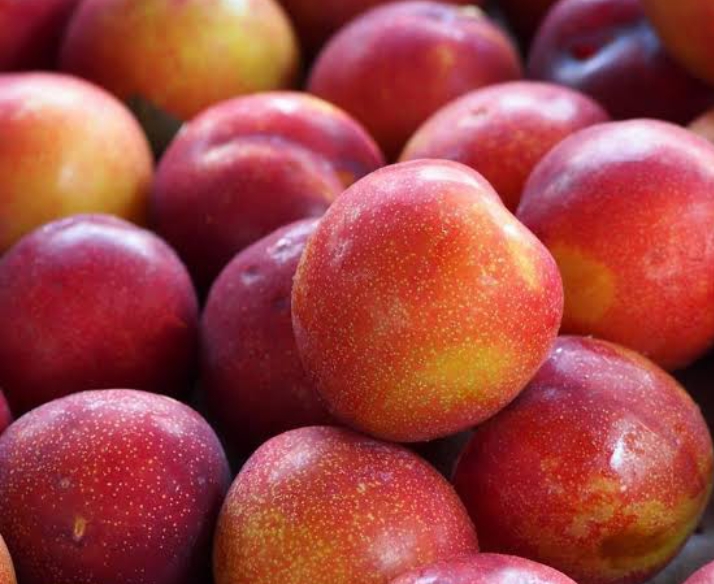
Amber Jewel plums are native to Western Australia. This plum is conical to cordate in shape with a prominent seam extending the length of the fruit. Skin is smooth and blushed with red. The flesh is golden yellow in color and is semi-fibrous, yet juicy.
The Amber Jewel plum is indeed very sweet, with a slight tanginess. Many people who have eaten it describe it as having a complex flavor profile, with notes of peach and citrus. It is so juicy and aqueous that some say it’s almost like drinking juice.
This plum variety is a mid-season variety, ripening in mid to late July. It is said that, when the fruit is fully ripe, it will have a slight give when gently squeezed.
According to university of California, Amber Jewel plum trees are self-sterile, that is, they require a different plum tree for pollination. Therefore, anyone planning to grow them need to understand that beforehand, to ensure proper pollination and a good fruit set. Suitable pollinators can be other hybrid or Japanese plum tree varieties.
Today Amber Jewel plums are cultivated in Australia, New Zealand, Turkey and in the United States. In fact, they are the most common plums shipped from Australia to Southeast Asia.
Damson Plum
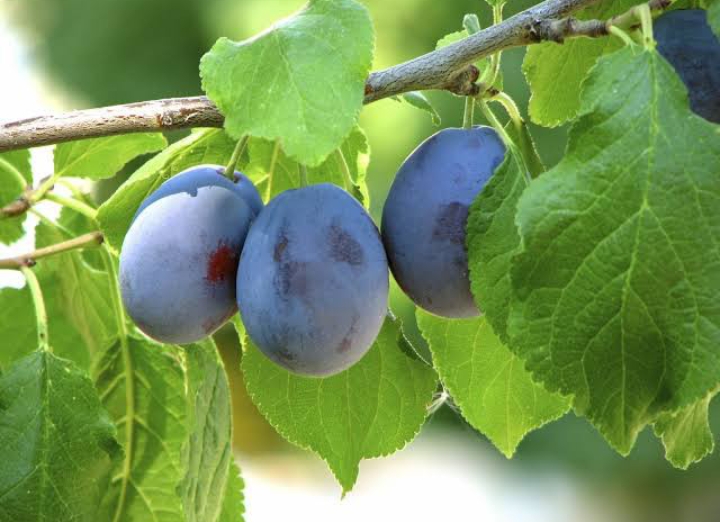
The fruit is believed to have originated in the areas around the Caspian Sea in western Asia, and it has been cultivated for centuries in different parts of the world.
The Damson plum has a dark blue to red-purple skin, covered in a powdery bloom that gives it a slightly dusty appearance. The flesh of the fruit is yellow-green, firm and juicy, with a sweet and tart taste that can vary in intensity based on the ripeness of the fruit.
The plums are generally considered too acrid for fresh consumption and are primarily utilized in cooked preparations. Some people even describe the Damson plums as the “jam-maker’s plum” because of their excellent gelling properties.
The exact time of the Damson plum harvest can vary depending on the location and climate, but in general, the fruit is available for harvest in late summer or early fall. In the Northern Hemisphere, this would be from August to October, while in the Southern Hemisphere, it would be from February to April.
Today Damson plums are somehow rare fruits that are not commercially cultivated. The plums are grown through specialty orchards in Europe and are also found in small quantities in United States.
Greengage Plums
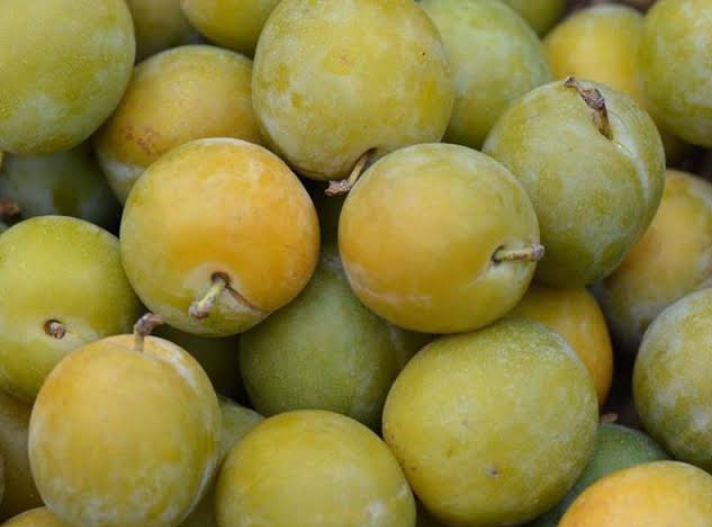
Greengage plums are believed to have originated in France, where they were first cultivated in the early 16th century. The variety was named after the French queen, Claude. From France, the cultivation of Greengage plums spread throughout Europe and eventually made its way to other parts of the world.
Greengage plums are small in size about the size of a golf ball, and are round in shape. They have a smooth skin that is greenish-yellow or pale green in color and may have a slight blush of pink or red. The flesh is succulent and aqueous in nature, bearing yellow-green hues with a translucent quality.
Many people say that these plums have a high sugar content with a pleasant flavor with notes of apricot, ripe mango or citrus.
Greengage plum trees grow to be about 15 or 20 feet tall in size. They have a moderate growth rate and begin to bear fruit within 3 and 5 years of planting. The fruit begins to ripen in late summer, with the peak harvest period being in August and September.
The fruit is usually ready for picking when it has reached its full size and the skin has turned from bright green to greenish-yellow. The fruit should be firm but slightly yielding to the touch.
Also Read: Different Types of Avocados
Mirabelle plums
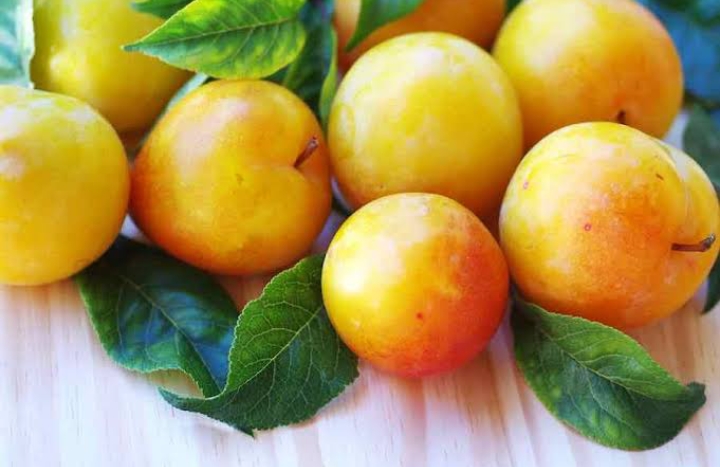
Mirabelle plum is a small, yellow plum variety that is also known as “Mirabelle de Nancy”. This plum variety is primarily grown in the Lorraine region of France, particularly around the city of Nancy and can also found in other parts of Europe and North America.
When fully ripe, the flesh of a Mirabelle plum is a bright yellow color with intense sweetness and flavor that is often described as honey-like with a tangy aftertaste. The flesh can also be said to be having a floral scent like that of apricots and other stone fruits.
Many people say that the flesh of this plum has a good chewiness to it that gives it a satisfying mouthfeel when eaten, and it is juicy enough to provide a burst of flavor with every bite.
Mirabelle plum trees grow to a height of about 20 feet. They are fast growing with a short lifespan of about 25 years. The trees are highly productive and can produce up to 100 pounds of fruit per tree in a good year.
The Mirabelle trees are early-season fruit trees, with their fruit ripening earlier than many other varieties of plums. But in general, the fruits will be available for harvest without fail in late summer, usually in late August or early September.
Methley plums
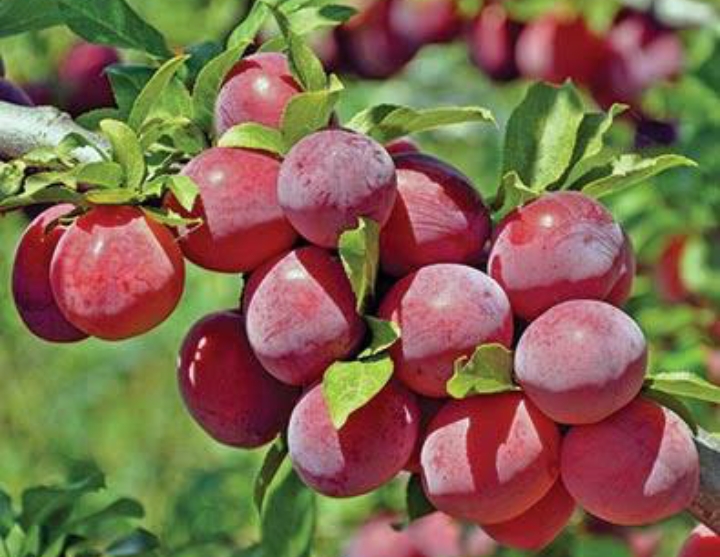
Methley plums are a variety of Japanese plum developed in the 1920s by Luther Burbank, a famous horticulturist, and plant breeder. Burbank developed Methley plums by crossing two Japanese plum varieties, Burbank’s own Satsuma plum and the Shiro plum.
The fruits are round in shape with a smooth and shiny deep purple skin that is covered in a waxy bloom. The flesh of this plum is burgundy or deep red in color. Inside the fruit, there is a small oval-shaped pit.
The flesh is very juicy and sweet. It features a rich flavor that is sometimes compared to that of a raspberry or a blackberry. Methley plums are generally known for having a high sugar content.
When fully ripe, the flesh of a Methley plum is very soft and can be easily eaten with a spoon. It also leaves a velvety feel in the mouth.
Methley plum trees grow to be between 10 and 20 feet tall with a moderately dense canopy. The trees can grow well in USDA zones 5 to 9 and reach their full size within 5 to 6 years. The tree is early-season in nature and in places like the northern hemisphere, the fruits will be ready to harvest between late June and early August.
Moyer plums

Moyer plums are a hybrid variety that was developed in California by a horticulturist named Ted Moyer. They are a cross between two other plum varieties: the Friar and the Queen Rosa. These plums are popular in many parts of the world, including the United States, Africa, Europe and Asia.
The skin of Moyer plums is dark burgundy to deep purple in color with a glossy texture. The flesh is firm and juicy with a yellowish color. The flesh surrounds a single hard pit or stone in the center.
The flesh is also quite flavorful. It has a tart and tangy taste that balances out the sweetness and makes it enjoyable to eat.
Moyer plum trees are medium in size and can reach heights of up to 15 feet. The trees are hardy and resistant to gardening of diseases and pests. The plums of these trees are ready for picking between September and October.
Catalina Plums
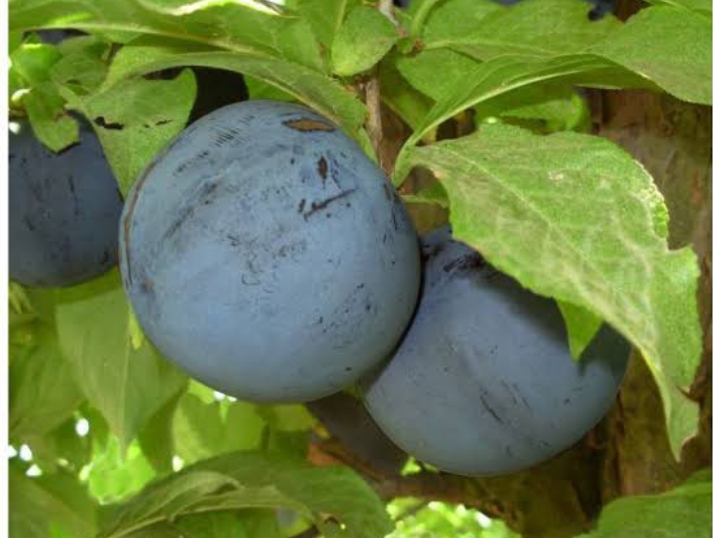
They are a hybrid fruit, developed by crossing the Santa Rosa plum and the Golden Nectar plum, and were first introduced in 1966 by a California-based fruit breeder named Zaiger.
They are considered a European plum variety with its dark purple skin and amber flesh. In other words, the flesh of the Catalina plum is yellowish-orange and has a firm texture that is not too soft or too hard. When ripe, they have a sweet, rich flavor that is both tart and juicy.
Catalina plum trees begin bearing fruit in their third or fourth year of growth, with peak fruit production occurring between the fifth and eighth years. The plums are usually in season from late June to early September.
Catalina plums are primarily grown in California, but can also be found in other parts of the United States, as well as in countries like Australia, France, New Zealand and South Africa.
Also Read: Most Expensive Fruits In The World
Burbank Plums
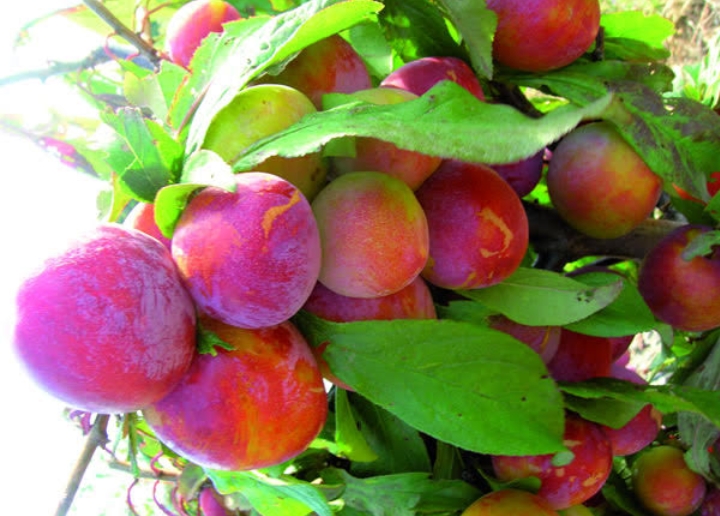
The Burbank plum is a heirloom Japanese plum cultivar named after a renowned American plant breeder, Luther created many new varieties of fruits and vegetables, including the Burbank potato and the Shasta daisy.
The Burbank plum fruit has a red-purple skin and yellow-green flesh. The skin of the fruit is thin and easy to peel, while the flesh is juicy and succulent, with a pleasing mouthfeel. The flavor is often described as having hints of honey and floral notes. The sweetness of the fruit is well-balanced with its slight tartness.
The Burbank plum trees are in season from mid to late summer, usually from July to September. In warmer climates, the fruit may ripen earlier in the season, while in cooler regions, it may ripen later. This variety requires cross pollination from another Japanese plum cultivar.
Santa rosa
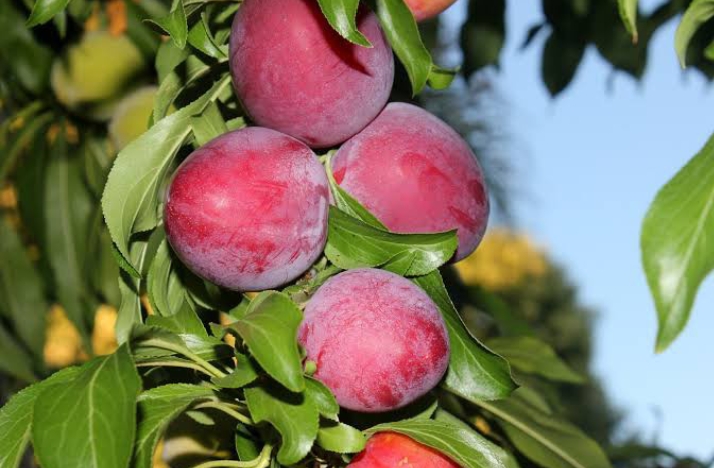
Santa Rosa plums are widely grown and enjoyed throughout the world. This variety is named after the city of Santa Rosa, California, where it was first developed by American plant breeder, Luther Burbank in 1906.
Santa Rosa plums have a deep purple skin and yellow flesh. The skin of the plum is a little fuzzy, and the flesh is firm and juicy with a mild tart finish.
The texture of these plums is firm and meaty, with a moderate crisp bite that gives way to the juicy flesh inside. When perfectly ripe, the flesh will be somehow soft to the touch but still hold its shape well.
Santa Rosa plums ripen and are ready for harvest between June and October depending on the climate and location.
The Santa Rosa plum tree is hardy in USDA zones 5 through 9. It produces high yields and self-pollinating in nature. The tree requires 400 chill hours and still works well as a pollinizer for other plum trees that need cross-pollination.
Italian Prune Plums

Italian Prune plums are native to the coastal Mediterranean regions of Italy. They are also sometimes referred to as Empress or Stanley plums. These plums are commonly found in the United States and Europe, particularly in Italy where they originated from.
Italian prune plums are small, egg-shaped black plums that are about the size of a large berry. Their smooth, thin skin carries the cloudy look of a blueberry. In other words, the color transitions from dark-red to purple and almost black hue with maturity. The plums are also covered in a powdery, white-blue bloom.
The flesh is juicy and tender, with a yellow-orange color. It is firm and somehow tart, with a sweet and tangy flavor that is not too overwhelming. When ripe, the flesh is soft and easy to bite into, with a pleasant texture that is neither too firm nor too mushy.
Italian Prune plum trees produce a significant quantity of fruit when in season. Their season is late summer through the early fall. Depending with location that is usually between June to October.
Also Read: Yellow Apples Varieties
Early Orleans plums
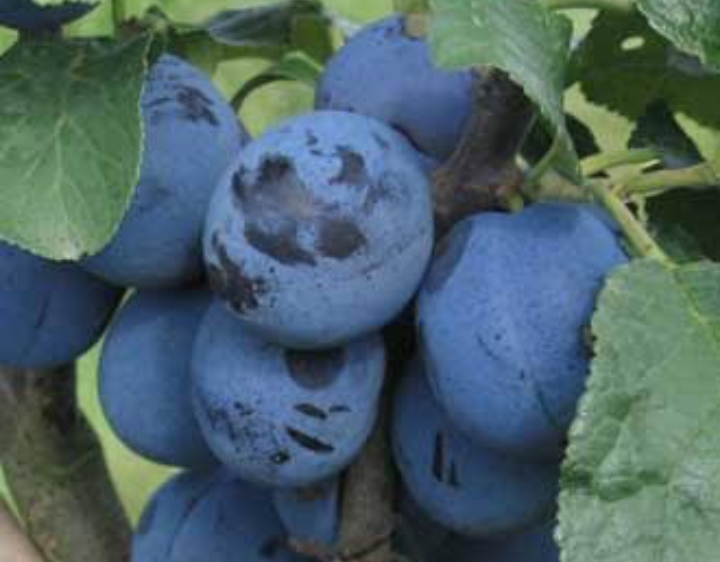
As the name suggests, Early Orleans plums have their origins in Orleans, France, a city located in the Loire Valley region. The variety is believed to have been first cultivated in the early 19th century, although the exact date and circumstances of its development are not well documented.
The fruit is round in shape with a black-purple skin that is covered in a light layer of bloom. The flesh is yellow and juicy, with a sweet and slightly tart flavor that is sometimes described by many people as “plummy.”
When the fruit is fully ripe, the flesh can be quite soft and easily yields to pressure. The flesh-to-pit ratio is relatively high. The fruits begin to ripen in late June or early July, which makes them one of the first varieties of plums to be available each year.
Today, Early Orleans plums are grown in many parts of the world. In the United States, the plums are grown in California, in the San Joaquin Valley region, which is located in the central part of the state.
Ozark Premier

Ozark Premier is a hybrid variety of plum. It is a cross between ‘Methley’ and ‘Burbank’. It was developed by the University of Arkansas fruit breeding program in the 1980s. It was specifically bred to be a larger, more flavorful plum that could be grown in the southern United States.
They have a dark purple skin that is slightly fuzzy to the touch, which gives them a rustic, old-fashioned look. These plums are sometimes referred to as “freestone” plums because flesh easily separates from the pit, making them easier to eat and process. The flesh is actually deep red in color and is very juicy and sweet.
Ozark Premier are mid-to-late season plums. They are harvested in July to October. They are grown in very many parts of Europe. In United States, they are grown in the central and southern United States, including states like Arkansas, Missouri, and Oklahoma.
Satsuma plums
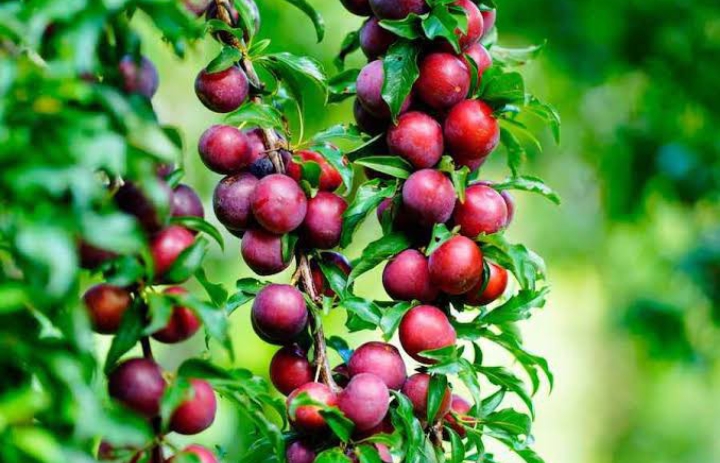
Satsuma plums were first cultivated in the Satsuma region of Japan, which is where they acquired their name.
Satsuma plums have a round shape, with a somehow flattened top. The skin is deep red to purple color, with a matte finish over a green base. The flesh is dark red and meaty offering a juicy consistency. They too have a single seed in the center, which is easy to remove.
The Satsuma plum tree is medium size and is suitable for growing in home landscapes. Although it can self-pollinate, it will produce a better crop if cross-pollinated by another Japanese plum variety, such as Methley, Toka or Santa Rosa.
Satsuma plums are in season during the summer months, from June through August.
In the United States, Satsuma plums were first introduced in the late 1800s and were initially grown in California. Today, they are still grown in California, as well as other states like Texas, Georgia, and Florida. They are also grown in other parts of the world such as Australia and South Africa.
Persian Sour plums
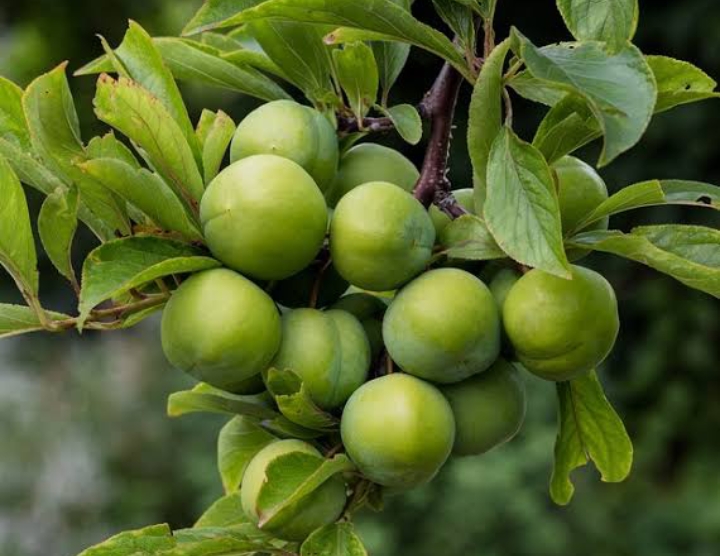
Persian Sour Plums, also known as Iranian Sour Plums are native to Iran and are popular around the world for their tart and acidic flavor.
Persian Sour Plums are actually green, with a glossy skin. They are actually smaller than other plum varieties. The flesh of these plums is firm and juicy, with a bright green color that ranges from pale to dark green depending on the level of ripeness.
As the name suggests, these Plums are very sour in taste, with a tartness that can be quite intense or similar to that of a lemon and lime. The acidity of the fruit is balanced by a hint of sweetness, this makes them a unique type of plum.
The fruit of the Persian Sour Plum tree is harvested between May and August. When ripe, the plums have yellow or golden hue, but they are usually harvested while still green.
Persian Sour plums contain high acidity when harvested young. If the plums are left to mature on the tree, the flesh will soften developing a sweet and subtly tangy flavor.
Shiro plums
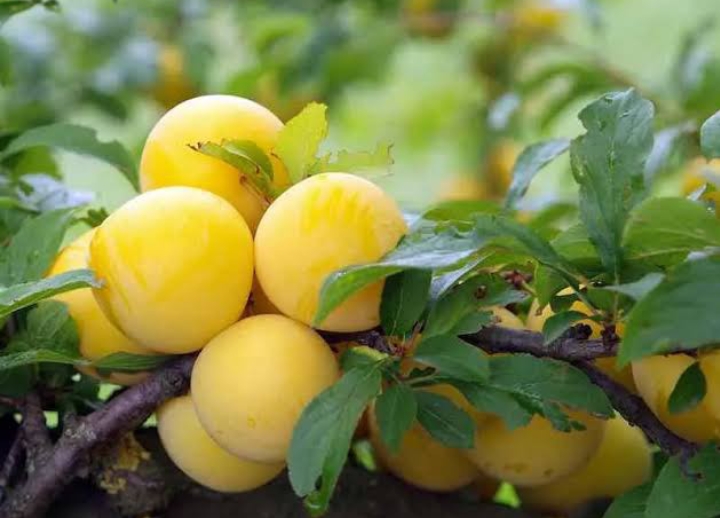
Despite often being listed as an Asian variety, Shiro plums were actually developed in the United States through a unique crossbreeding process involving four distinct plum varieties. These include the apricot plum and the Japanese plum from China, the cherry plum commonly found in Europe, and the Munson plum, which is native to North America.
The Shiro fruit has a smooth and firm skin with a yellow color that may have a light green blush. The flesh of the plum is juicy and tender, with a creamy yellow color and has very little acidity. When ripe, the fruit is soft to the touch and the skin may look somehow wrinkled appearance.
The Shiro plum tree can grow up to 25 feet tall with dense foliage. The trees are long-lived, and it is not uncommon to hear of Shiro plum trees that are over 40 years old.
Shiro plums are classified as clingstones, which means that removing the stone requires a little work. They may be eaten fresh out of hand. They also are good in desserts such as tarts and pies.
Vanier plums
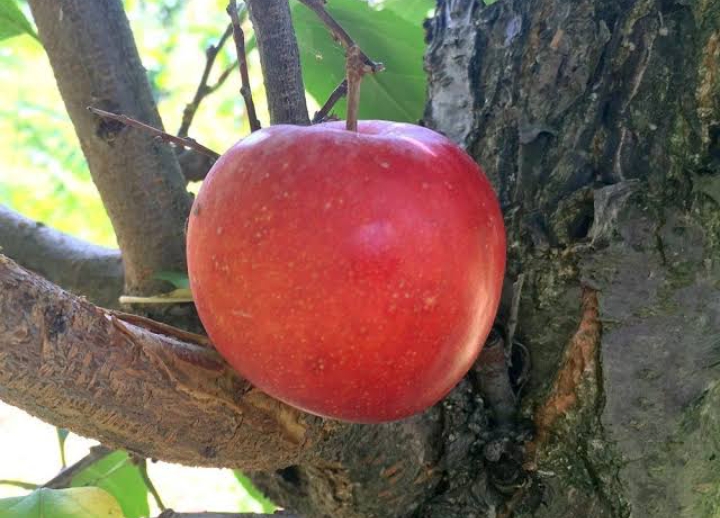
Vanier plum also referred to as Marie-Victorin plum is a hybrid plum variety that produces juicy fruits that resemble cherries. This plum variety is named after Brother Marie-Victorin, a Canadian horticulturist and botanist who was also a member of the Congregation of Holy Cross.
The plums are medium in size with a red to purple skin and yellowish-green flesh. The flesh is juicy and sweet. The flesh too has a small pit in the center, and the skin can be eaten or removed depending on personal preference.
When you eat a ripe Vanier plum, the texture is soft and juicy, which gives a pleasant mouthfeel. The flesh is tender and not too fibrous, so it is easy to chew and swallow.
Vanier plum trees are hardy and can tolerate cold temperatures down to -20°F. The trees are usually in season between September and October.
Bullace plums

Bullace plums are a variety of wild plum commonly found in Europe. These plums have a smooth, dark purple skin that is covered in a fine bloom or waxy coating. The skin is usually quite thin, and can be easily peeled away with a sharp knife or your fingers.
The size and shape of bullace plums can vary somewhat greatly. Some may be larger, medium or smaller. The flesh is firm and yellow-green in color, with a slightly tart and juicy flavor.
When eaten raw, bullace plums can be quite tart due to their high level of acidity. Some people may find the flavor of raw bullace plums to be too sour for their tastes. However, when cooked or baked, the tartness of the fruit tends to mellow out and become more balanced.
Mariposa plums
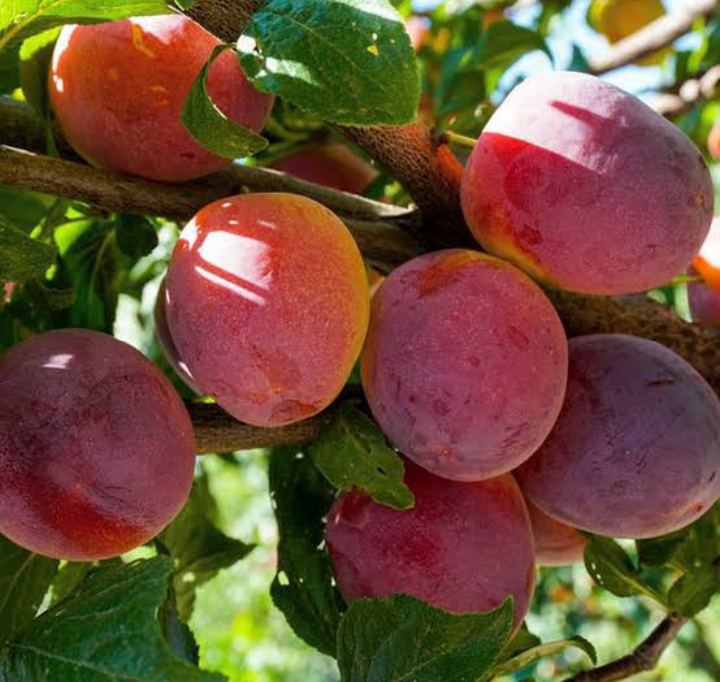
Mariposa plum is cultivar of Japanese plum. It was developed by American fruit breeder Luther Burbank in the early 20th century, at his experimental gardens in Santa Rosa, California.
The fruit has a deep purple skin that is covered in a fine layer of white bloom. The skin can sometimes be reddish-purple to a nearly black hue, but it is always dark and richly colored.
The flesh inside the plum is golden-yellow and firm, with a sweet flavor that is balanced by a slight tanginess. While the skin is edible, some people may choose to remove it before eating the plum.
When you take a bite of a ripe Mariposa plum, the firm flesh of the fruit gives way to a burst of sweet and juicy flavor, with a slight tanginess that lingers on the tongue.
Toka plum
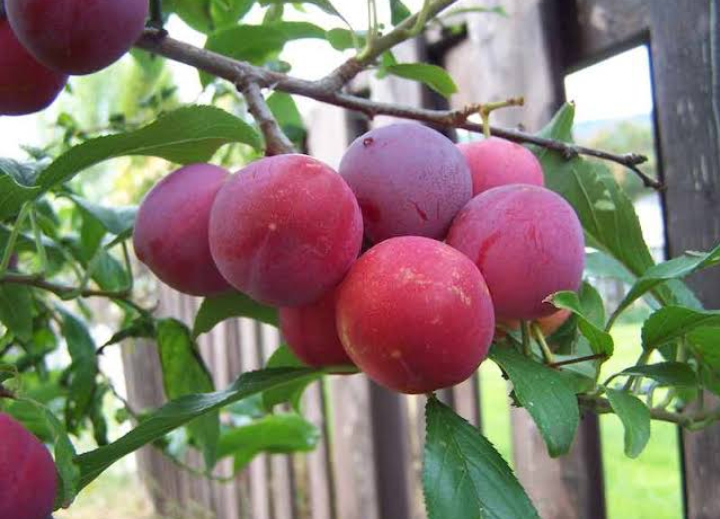
Toka plum is a hybrid cross between an American plum (Prunus americana) and a Japanese plum (Prunus salicina). The hybrid was developed in the by a breeder named Luther Burbank.
The fruit has a round shape and a reddish-purple skin with some little bloom or haze. The skin is firm but soft to touch when the fruit is ripe. The flesh is yellow with a mild flavor that is similar to apricots. Once you break through the skin, the flesh of the fruit is soft and juicy, with a melting quality that many have described as “buttery.”
Toka plum trees are self-sterile they need to be grown nearby a Japanese plum tree such as ‘Santa Rosa’ or ‘Shiro,’ for cross-pollination. The Toka tree is also cold-hardy fruit and can withstand cold winters. It is suitable for growing in USDA Hardiness Zones 3-8.